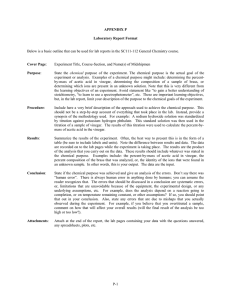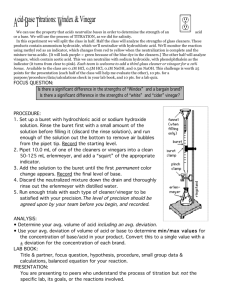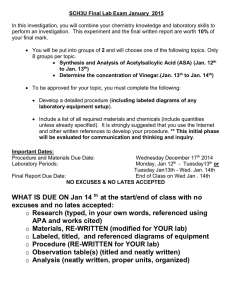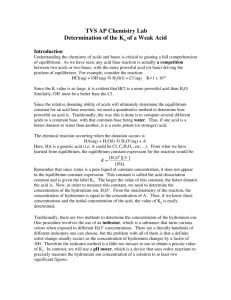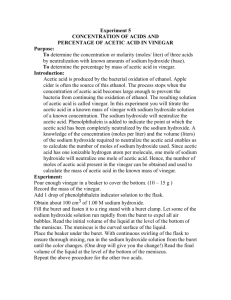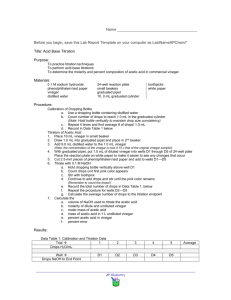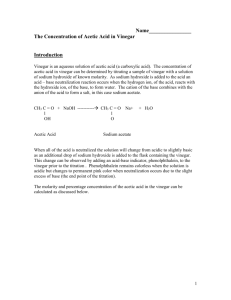SCHC-265
advertisement
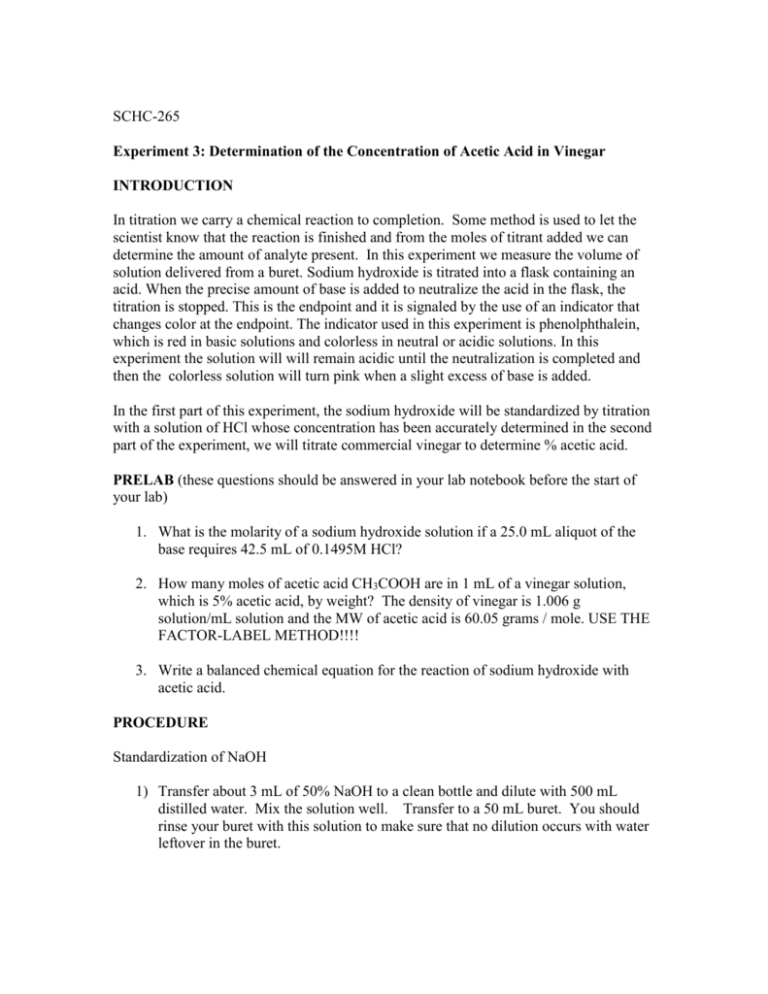
SCHC-265 Experiment 3: Determination of the Concentration of Acetic Acid in Vinegar INTRODUCTION In titration we carry a chemical reaction to completion. Some method is used to let the scientist know that the reaction is finished and from the moles of titrant added we can determine the amount of analyte present. In this experiment we measure the volume of solution delivered from a buret. Sodium hydroxide is titrated into a flask containing an acid. When the precise amount of base is added to neutralize the acid in the flask, the titration is stopped. This is the endpoint and it is signaled by the use of an indicator that changes color at the endpoint. The indicator used in this experiment is phenolphthalein, which is red in basic solutions and colorless in neutral or acidic solutions. In this experiment the solution will will remain acidic until the neutralization is completed and then the colorless solution will turn pink when a slight excess of base is added. In the first part of this experiment, the sodium hydroxide will be standardized by titration with a solution of HCl whose concentration has been accurately determined in the second part of the experiment, we will titrate commercial vinegar to determine % acetic acid. PRELAB (these questions should be answered in your lab notebook before the start of your lab) 1. What is the molarity of a sodium hydroxide solution if a 25.0 mL aliquot of the base requires 42.5 mL of 0.1495M HCl? 2. How many moles of acetic acid CH3COOH are in 1 mL of a vinegar solution, which is 5% acetic acid, by weight? The density of vinegar is 1.006 g solution/mL solution and the MW of acetic acid is 60.05 grams / mole. USE THE FACTOR-LABEL METHOD!!!! 3. Write a balanced chemical equation for the reaction of sodium hydroxide with acetic acid. PROCEDURE Standardization of NaOH 1) Transfer about 3 mL of 50% NaOH to a clean bottle and dilute with 500 mL distilled water. Mix the solution well. Transfer to a 50 mL buret. You should rinse your buret with this solution to make sure that no dilution occurs with water leftover in the buret. 2) Using a volumetric pipet, place 25.00 mL standardized HCl into a clean 250 mL beaker. Add 5-6 drops of phenolphthalein. Do a fast titration to determine your approximate endpoint. Enter in your notebook, but do not use for the calculation of the molarity. 3) Titrate three more samples of HCl. Titrate quickly to within 5 mL of your endpoint then titrate drop wise, using split drops at the endpoint. Try to obtain the same intensity of light pink for each endpoint for all three titrations. Your agreement should be within 1%. Is this precision or accuracy? PATIENCE IS A VIRTUE Determination of Acidity 1. Pipet 5.00 mL of vinegar into a 250 mL beaker. Add 15 mL of distilled water and 5-6 drops Phenolphthalein. Do a quick endpoint determination and three more careful titrations. If your values are not within 1% of each other, repeat. Average your three values. 2. Using a density of 1.006 g/mL for vinegar, calculate % (by weight) of acetic acid in this solution. The FW of acetic acid is 60.05 grams/ mole. Compare your answer to the value on the bottle or provided by the instructor. REPORT For each set of three titrations, report the mean, standard deviation and RSD in parts per thousand; propagate the uncertainty. Also calculate the 95% confidence interval for your % (by weight) of acetic acid in vinegar. Obtain the data from one class-mate that analyze the same type of vinegar that you analyzed. See if you got the same value. Use a Case 2 t-test. Compare your data for to the known value of acetic acid in vinegar (assuming the value on the vinegar bottle is accurate to two decimal places, e.g., 5.00%). Perform a Case 1 t-test. Compare your result with the known value. Comment on your precision. Is your experimental value statistically different from the known value? Comment on your error. LABORATORY REPORT: The laboratory report will consist of the following ABSTRACT - a one paragraph summary of the entire experiment. This includes theory, procedure, results and conclusions. See examples in the journal ANALYTICAL CHEMISTRY. INTRODUCTION - A presentation of background information. This section will include a short theory section that demonstrates your understanding of the experiment. NOTE: PLAGIARISM WILL NOT BE TOLERATED. IF A STUDENT IS FOUND TO HAVE PLAGIARIZED THEIR REPORT FROM EITHER THE CHEMICAL LITERATURE OR FROM A CLASSMATE THEY WILL RECEIVE A GRADE OF F FOR THE COURSE. EXPERIMENTAL - this is not a procedure section! A brief explanation of the experimental protocol, giving those details needed by an experienced chemist. DATA - A clear presentation of all information gathered in the laboratory. Tables and graphs are necessities. CALCULATIONS - A sample of any numerical calculations, presented in a logical fashion. RESULTS/DISCUSSION - The most important portion of the report. Clearly explain your data and demonstrate how it does or does not fit the theory. Accuracy and precision are important here as is a presentation of reasonable sources of error, a correctable error is not reasonable. Explain your experiment completely and succinctly! Answer to questions in lab handout. Grammar, spelling, clarity of presentation and neatness can also significantly affect your grade. Overall, these reports should be very concise and to the point and written with a scientific, not liberal arts, vocabulary!
